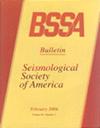Ground‐Motion Model for Small‐to‐Moderate Potentially Induced Earthquakes Using an Ensemble Machine Learning Approach for CENA
IF 2.9
3区 地球科学
Q2 GEOCHEMISTRY & GEOPHYSICS
引用次数: 0
Abstract
Ground‐motion models (GMMs) are vital in assessing probabilistic seismic hazards and uncertainties. This study develops new GMMs benefiting from nonparametric machine learning algorithms, including artificial neural networks, kernel ridge, random forest, and gradient boosting regression techniques for small‐to‐moderate potentially induced earthquakes in central and eastern North America (CENA). As part of this study, we evaluate the performance of different machine learning models in estimating peak ground acceleration (PGA) and 17 spectral accelerations based on the moment magnitude (Mw), hypocentral distance (Rhypo), and the timed‐average shear‐wave velocity of the upper 30 m of soil (VS30). To train the algorithms, we have utilized a database of nearly 31,000 ground motions with small and moderate moment magnitudes ranging from 3.0 to 5.8, recorded within a hypocentral distance of less than 200 km in CENA. Typically, for GMM development, analysts employ linear regression‐based models with predefined functional forms. The requirement for predefined functional forms can restrict the use of complicated and nonlinear equations to improve performance. Although the conventional regression model is more interpretable, machine learning can achieve a better result given sufficient training data. The results of error metrics reveal that gradient‐boosting regression provides a better performance. Furthermore, a machine learning ensemble method is used to combine the regression results of four machine learning algorithms. The ensemble method improves the GMM performance and provides smoother results.为 CENA 使用集合机器学习方法建立中小规模潜在诱发地震的地动模型
地动模型(GMMs)对于评估概率地震危害和不确定性至关重要。本研究利用非参数机器学习算法(包括人工神经网络、核岭、随机森林和梯度提升回归技术)开发了新的地动模型,用于北美中部和东部(CENA)的小中度潜在诱发地震。作为该研究的一部分,我们评估了不同机器学习模型在估算峰值地面加速度 (PGA) 和基于矩幅 (Mw)、次中心距 (Rhypo) 和上层 30 米土壤定时平均剪切波速度 (VS30) 的 17 个频谱加速度方面的性能。为了训练算法,我们使用了一个数据库,其中包含近 31,000 次小型和中型地震动,矩幅从 3.0 到 5.8 不等,记录范围在 CENA 下中心距离不到 200 千米的范围内。通常情况下,在开发 GMM 时,分析人员会采用基于线性回归的模型和预定义的函数形式。对预定函数形式的要求会限制使用复杂的非线性方程来提高性能。虽然传统的回归模型更容易解释,但如果有足够的训练数据,机器学习可以取得更好的效果。误差指标的结果表明,梯度提升回归法的性能更好。此外,还使用了机器学习集合方法来综合四种机器学习算法的回归结果。该集合方法提高了 GMM 性能,并提供了更平滑的结果。
本文章由计算机程序翻译,如有差异,请以英文原文为准。
求助全文
约1分钟内获得全文
求助全文
来源期刊

Bulletin of the Seismological Society of America
地学-地球化学与地球物理
CiteScore
5.80
自引率
13.30%
发文量
140
审稿时长
3 months
期刊介绍:
The Bulletin of the Seismological Society of America, commonly referred to as BSSA, (ISSN 0037-1106) is the premier journal of advanced research in earthquake seismology and related disciplines. It first appeared in 1911 and became a bimonthly in 1963. Each issue is composed of scientific papers on the various aspects of seismology, including investigation of specific earthquakes, theoretical and observational studies of seismic waves, inverse methods for determining the structure of the Earth or the dynamics of the earthquake source, seismometry, earthquake hazard and risk estimation, seismotectonics, and earthquake engineering. Special issues focus on important earthquakes or rapidly changing topics in seismology. BSSA is published by the Seismological Society of America.
 求助内容:
求助内容: 应助结果提醒方式:
应助结果提醒方式:


